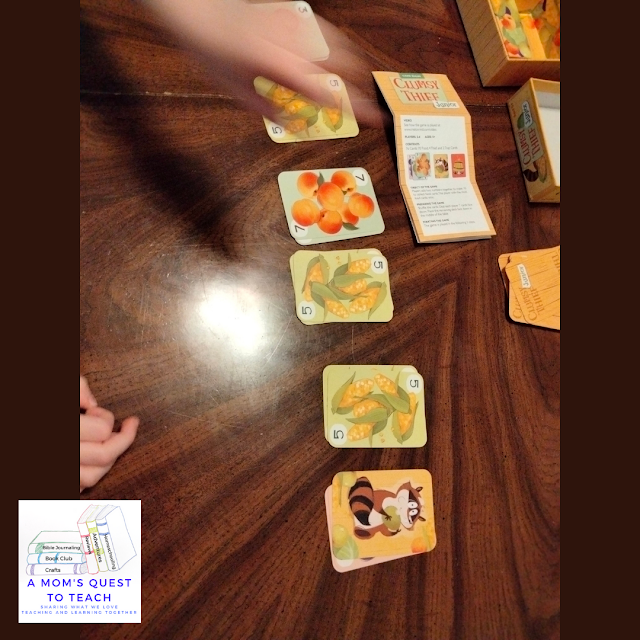I received a COMPLIMENTARY copy of
this game from the Timberdoodle in exchange for my honest opinion. I was not
required to write a positive review, nor was I compensated in any other way.
This post contains tracking links. For more information, please see my Terms
of Use and Disclosure Policy page. Thank you.
Learning addition math facts will help our children in all their future mathematics courses. One of the areas where I would like our six-year-old daughter to get practice in is in addition. We recently had the opportunity to add the game Clumsy Thief Junior, which is part of the 2021 Kindergarten Curriculum Timberdoodle Kits, into our homeschooling lessons. What a fun game to help our daughter practice adding numbers that make ten!
About the Game - Clumsy Thief Junior
The deck, consisting of 76 cards total, and instructions come in a cute box featuring a raccoon eating an apple on the cover of it. The seventy food cards are labeled with colorful fruit and vegetables and the numbers one through nine. The four thief cards feature a raccoon eating a pear, holding lettuce, and two holding an ear of corn. The two trap cards show the same picture of a basket over top of the raccoon.
The object of Clumsy Thief Junior is for the players to make ten to collect food cards. Each player starts with seven cards and then the game follows these steps:
- Everyone makes stacks of ten with the cards in their hand. They will use two cards with the same food to add to exactly ten.
- After everyone has made all their stacks of ten, players will begin collecting stacks. This is done by looking at everyone's stacks in front of them and seeing if you can add any cards from your hand to the top card to add to ten. For example, someone's stack is showing a four lettuce card, and you have a six lettuce card. You can put the six lettuce card on their stack and take the stack for yourself. This can be done until everyone is done making stacks using the cards in their hands.
- The next step is to replenish your stack up to five cards.
- Repeat the steps until the entire card deck is gone.
How Do You Win?
Using the Game – Clumsy Thief Junior in our Homeschool
When I requested to review the game Clumsy Thief Junior, I had our daughter in mind. She was just finishing kindergarten, and I thought it would be perfect to help her practice her addition skills. One problem – she does not like to play competitive games. She doesn't like losing or winning. She prefers cooperative games, but knowing that learning addition math facts is important, I pushed her to join us in our second game of Clumsy Thief Junior. And she was very glad she did. She had a lot of fun. She told me it was fun to win against her brothers and her dad.
We played the game several times with everyone in our family. From our six-year-old to our 18-year-old, we all had fun. Our eight-year-old son was really into the game. He enjoyed 'stealing' stacks from his siblings and his parents but he also loved cheering everyone else on as we played the game. I liked how fast the game was which makes it perfect to fit into our homeschool day or just to play when we have some free time after dinner.
Extending the Learning Beyond the Game
We love homeschool materials – like games – which we can use in a variety of ways beyond the normal game mechanics or rules. There are several different ways in which we can use the cards that accompany Clumsy Thief Junior in our homeschool lessons. And with the box being such a convenient size, it is very easy to store with all our homeschooling supplies.
After removing the four thief cards and the two trap cards, children can pick from the deck and do a number of things:
- They can write the word for the number card they have chosen.
- They can think of one or more ways in which you can add to get the number on the card. For example, if they choose the number nine, they could tell you that 1 +8 = 9 or 2 + 7 = 9.
- Ask your child to tell you what number gets added to that card to equal ten.
- If you are studying a foreign language, ask your child what that number is in Spanish, Latin, French, etc.






No comments:
Post a Comment